Are you sure you have the right approach to education? Most people don’t stop to ask themselves this question. They believe educational strategies that are both enjoyable and effective don’t exist. Despite this attitude, a little bit of self-analysis could radically change their attitude toward education and take their academic results to a new level.
Just imagine how easy learning even the most difficult subjects can be once you reevaluate your abilities and thinking patterns. Metacognitive strategies teach you how to improve your learning methods by evaluating their effectiveness.
Our team has created a detailed guide to get you acquainted with metacognition. We’ll describe the nuances of applying the practice to improve individual learning programs. You can practice strategies from our article and see how metacognition can change your life!
🧐 What Is Metacognition?
The term metacognition was created by American developmental psychologist John H. Flavell in 1979. He is commonly believed to be the founder of this field. To summarize his work, metacognition refers to a person’s ability to plan, monitor, evaluate, and adapt their learning style. Different metacognitive strategies seek to restructure the learning mechanisms people develop during childhood.
Aside from teaching people how to improve their education, the notion touches upon the importance of self-regulation and self-awareness. Metacognition also emphasizes problem-solving and critical analysis skills. It allows students, or anyone interested in self-education, to learn better by optimizing cognitive processes. Metacognition helps them tackle challenging subjects more effectively.
💡 Why Is Metacognition Important in Learning?
There are several reasons why metacognition plays an essential role in education. First, it creates additional neural pathways in the brain, making learning and retaining information easier. Second, this approach helps develop and maintain educational strategies. You can use it to plan, choose practical learning tools, develop healthy habits, and address your weaknesses. In a nutshell, metacognition helps students establish the proper learning methods and conditions.
Elements of Metacognitive Learning
As mentioned before, metacognitive education allows you to understand and control your learning process. It contains several components: attention, memory, comprehension, and thinking.
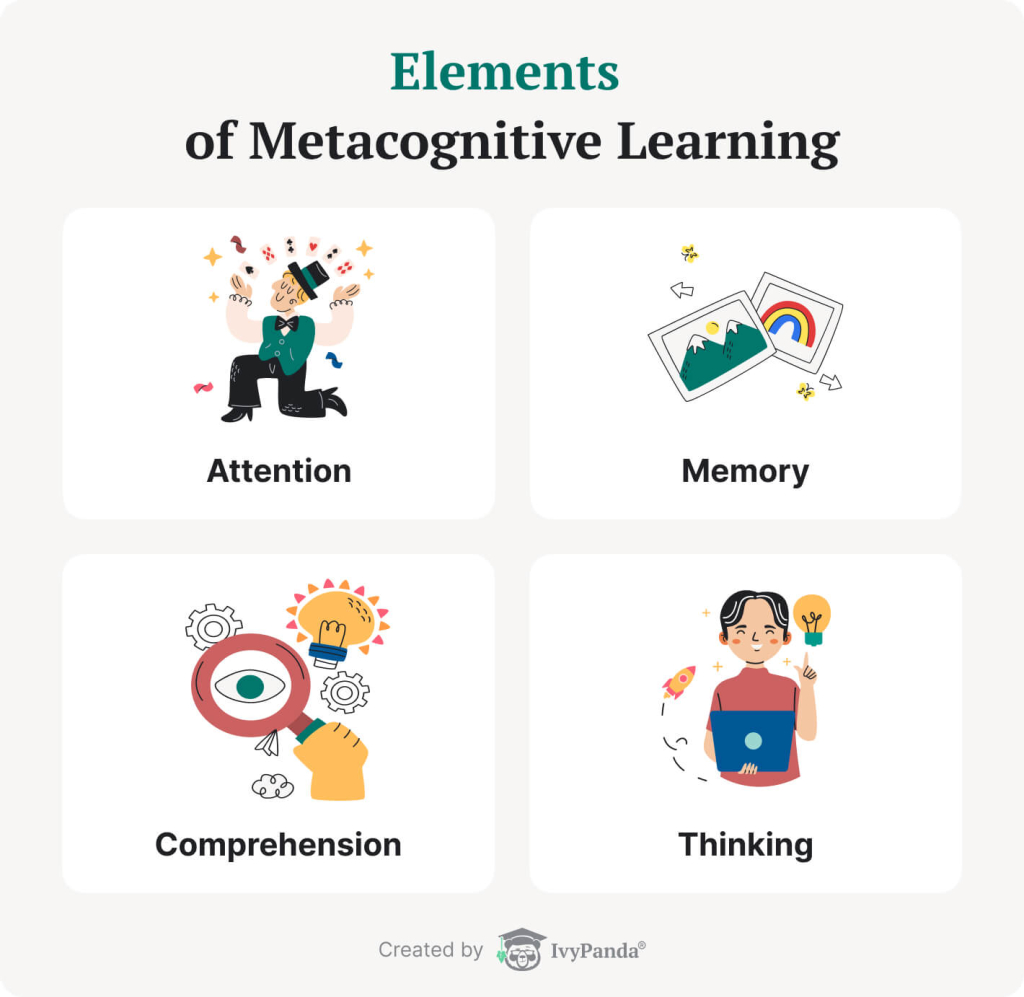
Here, we’ll analyze the function and meaning of these elements.
- Attention. This cognitive function allows people to focus on particular things. They use it to pay attention to others, sounds, movements, texts, and objects. When you watch a movie, your attention keeps you focused on what’s going on the screen. Your mind removes other stimuli and information irrelevant to the current moment.
- Memory. This is the primary cognitive process that governs our mental organization. Memory allows people to obtain, store, retain, and recall past experiences and information. It helps individuals discern the past from the present and reuse previous and present experiences. It’s related to learning, but that isn’t all there is to it.
- Comprehension. This cognitive process enables people to find connections between new and old data. It helps individuals better comprehend subjects by combining novel and old information. This data is used to solve hypothetical scenarios and real-life problems.
- Thinking. Thinking is a process that uses long-term memory data to develop solutions, make judgments, and come to conclusions. People use this cognitive activity to make sense of their environment and respond to it. This can help them to be more in sync with different social groups. Thinking also helps individuals understand their inner world.
📚 Two Aspects of Metacognition
Metacognition is commonly divided into two separate but related aspects: metacognitive knowledge and metacognitive control. The first notion allows people to realize their cognitive operations and abilities. The second aspect enables them to regulate and correct these processes based on circumstances. Both are important for effective learning. That’s because they let individuals track their learning progress and adjust according to different approaches.
Metacognitive Knowledge
This idea encompasses your knowledge about cognitive processes in yourself and others. Metacognitive knowledge may be used to evaluate a person’s mental capacity, memory, and learning abilities. It’s relatively stable and works like an intuitive model of knowledge and its processes. People may access this information, discuss it, and reflect on it. However, this data may lead to false ideas and warped reasoning.
Components of Metacognitive Knowledge
This metacognitive type has the following characteristics:
- Personal variables. Metacognitive knowledge allows people to look at themselves as learners and thinkers. It helps evaluate experiences and abilities applied to different tasks. For example, you may find out you’re better at remembering faces than names.
- Task variability. This component involves varying levels of difficulty in different objectives. For example, learning physics calls for more effort than studying literature. And changing tires is more complicated than refilling the windshield wiper fluid.
- Strategic variables. This area refers to knowing how to execute tasks. People often have several strategies for tackling assignments.
Metacognitive Control
This notion refers to the attributes of regulation, organization, and supervision that change according to the current learning situation. Metacognitive control keeps people alert to possible failures and helps them act in a manner that reduces them. The cognitive process is active before, during, and after finishing a task. This allows you to plan for a learning session by selecting the necessary problem-solving skills and strategies. Metacognitive control also lets people evaluate their comprehension of text and progress in completing a task.
Components of Metacognitive Control
Next, we’ll explore the main elements of metacognitive control:
- Planning. Before beginning a task, you need to make an effective strategic plan. This requires gathering resources and approaches that are necessary for the end goal.
- Supervision. This component includes adjusting and revising actions needed to advance a task toward the set goal. Under this process, errors are identified and corrected.
- Evaluation. Finally, metacognitive control allows students to evaluate the results of their work. This information helps them better prepare for working on new tasks.
🧩 Essential Metacognitive Skills
Metacognitive skills are thinking abilities that help you feel and control your thought process. They include self-awareness, self-control, planning, and goal setting. These factors are crucial in achieving academic results. Next, we’ll take a look at the most important of them.
The Metacognitive Experience in the Learning Process
Put simply, the metacognitive experience is a person’s internal response to learning. Emotions and feelings provide feedback that helps individuals understand their expectations and progress in a subject. For example, if you feel frustrated when learning a language, it shows that the chosen approach might not be the most efficient. Likewise, you might be doing well if education brings you primarily positive emotions.
🌟 5 Benefits of Metacognition in Learning
Metacognitive knowledge will give you a significant advantage in understanding your cognitive processes and self-awareness.
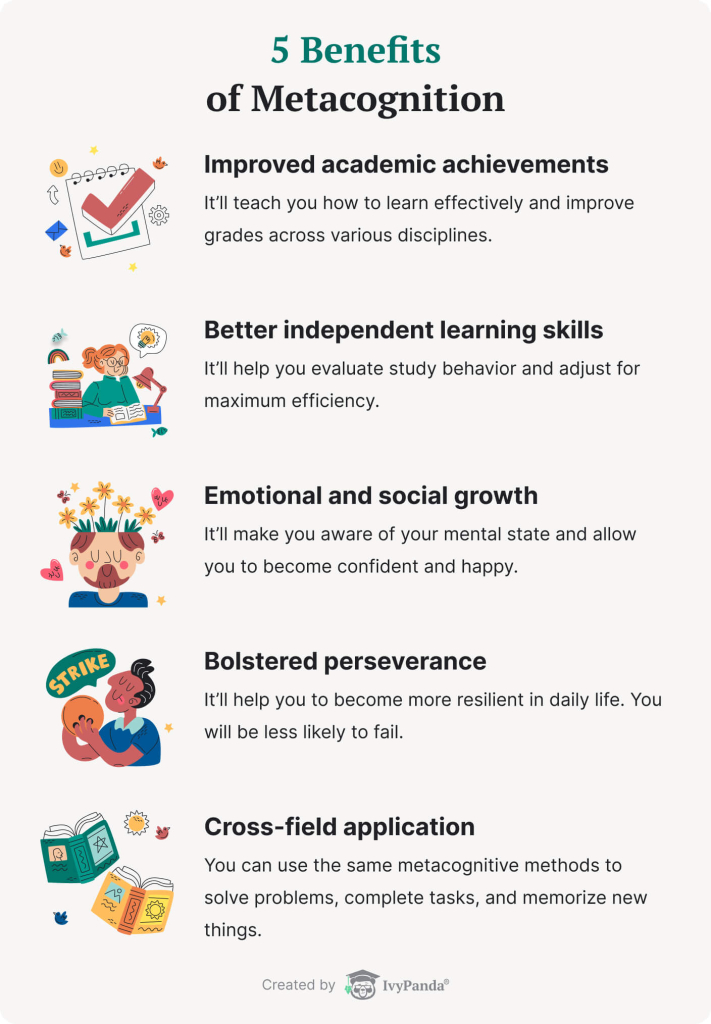
Here are five main benefits you’ll get from developing your metacognitive awareness:
- Improved academic achievements. Teaching students how to learn more effectively improves their grades across various disciplines. These skills help them use previous knowledge and practices for new assignments. Metacognitive methods also benefit individuals with different cognitive limitations.
- Better independent learning skills. The field of metacognition teaches students to become more efficient learners. They can evaluate their study behavior and make adjustments for maximum efficiency. These methods are applicable inside and outside the classroom.
- Emotional and social growth. Awareness of their mental state allows students to understand how to become confident, happy, and respected. Metacognition also helps them step into the shoes of others.
- Bolstered perseverance. Identifying failures, successes, and the most effective learning strategies helps students become more resilient in their daily life. They’ll be less likely to fail since they will have a clear understanding of what works and what doesn’t.
- Cross-field application. The best part about metacognition is that it can be applied across all areas of knowledge. People can use the same methods to solve problems, complete tasks, and memorize new things. These skills can be applied to mathematics, learning languages, writing skills, or other activities.
🏆 9 Best Metacognitive Learning Strategies
Metacognitive learning strategies give a new perspective on studying and preserving information. We’ve prepared the most effective approach, but keep in mind that the best learning methods are those adapted to your individual needs and goals.
You should first determine which of your cognitive characteristics are strong and which are weak. After completing this process, it’s possible to use our proposed strategies and adapt them to your perceptions, needs, and opportunities. They will surely help you reach your desired results in your education.
Practice Reflection and Meditation
Meditation practice allows people to calmly reflect on many aspects of their mental state. Students can take the time to examine their cognitive processes through this action. Reflecting or meditating on past experiences is one of the purest forms of metacognitive evaluation. Mindfully focus on your learning habits during meditation, as well as your breath.
There are several benefits to this approach. It allows you to clear your head of its everyday chatter. Meditation also puts you in a more focused and calm state that can enhance the learning experience. Lastly, it makes you aware of your inner thoughts. Some schools in the United States use meditation to make students more self-aware in the classroom.
Identify Strengths and Weaknesses
To take full advantage of metacognition, you should first evaluate your strengths and weaknesses. This is the only way to fully comprehend which areas require work. The SWOT chart is an excellent framework to use. It gives a clear picture of a person’s assets and shows what needs improvement.
Think Out Loud
Sometimes, people have challenges comprehending ideas when reading material in silence. Many find they can make more sense of the study material after verbalizing their thoughts. Summarizing out loud can also show you how well you understand something you’ve read. This requires retracing your steps and gradually explaining concepts to yourself.
The practice of thinking out loud shows if there are any gaps in your understanding. Repeating this process several times ensures you’ll have a good grasp of what you’re learning. If you still struggle, try explaining the concept to your peers, tutors, or even pets. This makes the thinking process more structured and helps you learn faster.
Ask Yourself Questions
This metacognitive strategy ensures students pause when working on tasks. This is done to help them question their actions. With this process, people can become aware of their drawbacks and shortcomings. Asking yourself questions improves your learning abilities and can be used in other aspects of life.
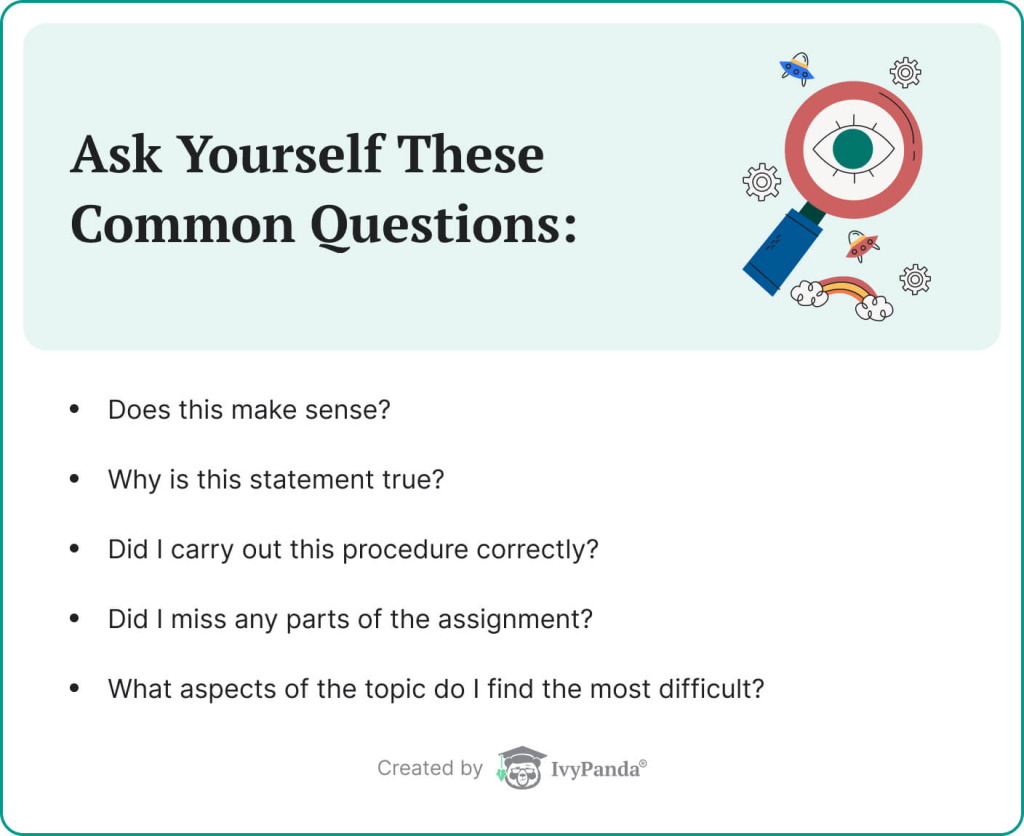
Try Active Reading
Occasionally, students scan through text without paying attention to what it says. The practice of active reading gives them clear intent to comprehend and evaluate study materials. It involves a higher level of critical awareness by asking essential questions. These include “What?”, “Where?”, “When?” and “Why?”. Here are several examples of active reading strategies:
- Make annotations. When reading, write down your thoughts, highlight important parts, and annotate the text. The more you do this, the better you’ll understand and remember the materials.
- Research unfamiliar words. If you come across unknown terms and concepts, research and comprehend them. It’ll expand your vocabulary. Otherwise, you might not understand everything the text says.
- Establish main ideas. To understand a subject in all aspects, you must identify its main themes and concepts. This will give you a better understanding of the author’s intended message.
- Ask questions. An excellent active reader should always pose questions and find answers. Stay curious and be sure to understand what the text is about, as well as its underlying meaning.
- Find connections between ideas. When reading a significant volume of text, do your best to identify patterns and relationships between its different concepts and notions. To make this process easier, construct diagrams or draw pictures of how things tie in with each other.
Use Mnemonic Devices
This type of cognitive strategy helps students improve their retention of information. Mnemonic devices use associations, patterns, and rhymes to enhance learners’ memory The method adds context to facts that help recall them. For example, one may use rhymes to remember other people’s names better. Mnemonics also commonly use acronyms to memorize things like the Great Lakes or the planets in the solar system.
Implement Active Listening
Like active reading, this activity emphasizes utter concentration while listening. It’s more challenging to master and takes time to develop. This skill is about more than just paying attention to what’s being said. The process requires actively paying attention to what the speaker does and shows.
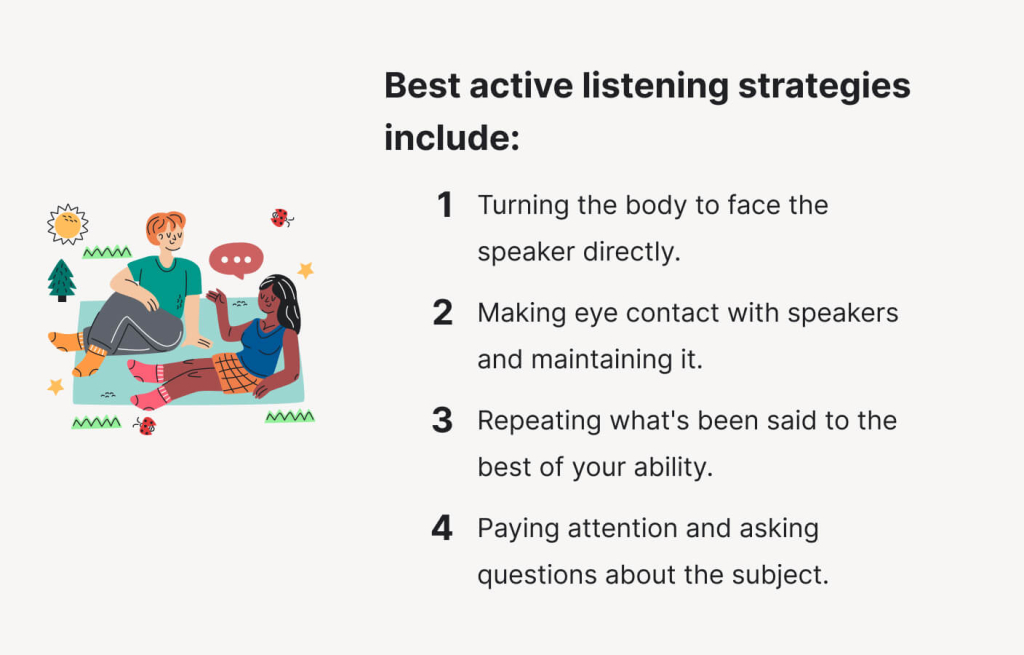
Plan Ahead
This metacognitive activity will serve you well in your learning journey. Planning makes tracking academic tasks and working on individual projects easier. It helps you decide on the activities for different assignments before starting them. Pre-planning also gives you time to determine which cognitive practices will be the most appropriate for particular projects.
Having a prepared plan makes you remember previous mistakes and avoid them. Lastly, it lets people take stock of the tools required for a new activity. Some of them track the progress of assignments and ensure that you stay on track. These can be simple as timers, schedules, or dedicated apps.
Apply Graphic Organizers
The purpose of these cognitive tools is to help people improve their thinking. Graphic organizers help students to structure their thoughts better. They also help make connections between things they know. With the help of these tools, you can develop a deeper understanding of concepts and give them a visual form.
Some of the broadest types of graphic organizers include flow charts, spider diagrams, and mind maps. These frameworks will help you find patterns and relationships you haven’t considered before. Combined, these features make your knowledge more structured and easier to expand. Studying new subjects will come naturally since you have previous experience using graphic organizers.
Metacognitive learning strategies are a potent instrument. They can make your studies more comfortable and open up new horizons for you. Set goals, track your progress, think about your learning experience, and analyze your strengths and weaknesses. If you have friends who will find our article interesting and informative, share it with them!
📎 References
- Metacognitive Strategies (How People Learn). – Center for Teaching Innovation, Cornell University
- Metacognition in Action. – State Government of Victoria
- The 3 Components of Metacognition. – Catherine Meilleur, KnowledgeOne
- Training in Attitude, Action, and Impact. – The School of We
- What is Metacognition? – The University of Arizona
- Metacognitive Processes. – LINCS, Community, Courses, and Resources for Adult Education
- Metacognition. – The University of Texas at Austin
- 8 Ways to Develop Metacognitive Skills. – InnerDrive
- Active Reading Strategies: Remember and Analyze What You Read. – The Trustees of Princeton University
- 11 Active Listening Skills to Practice (With Examples). – Jennifer Herrity, Indeed
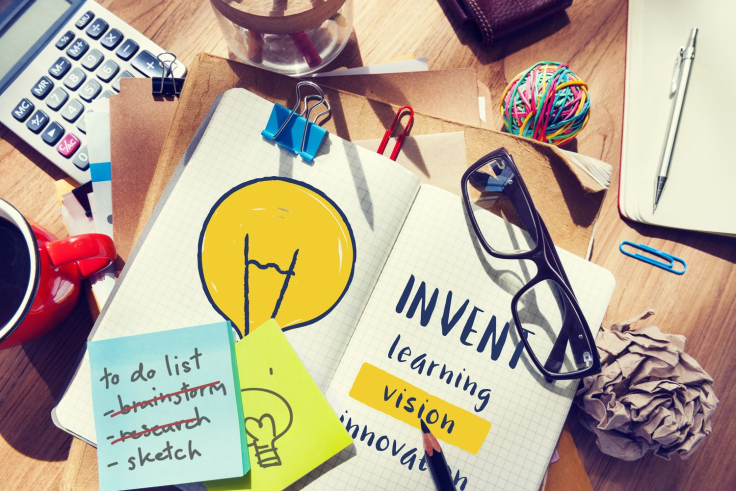
![Your First Year of College: How to Prepare & Be Successful [+ Infographic]](https://ivypanda.com/blog/wp-content/uploads/2023/03/shocked-fuuny-young-female-wonk-stares-notebook-carries-pen-has-piles-papers-workplace-wears-spectacles-striped-clothes-309x208.jpg)

